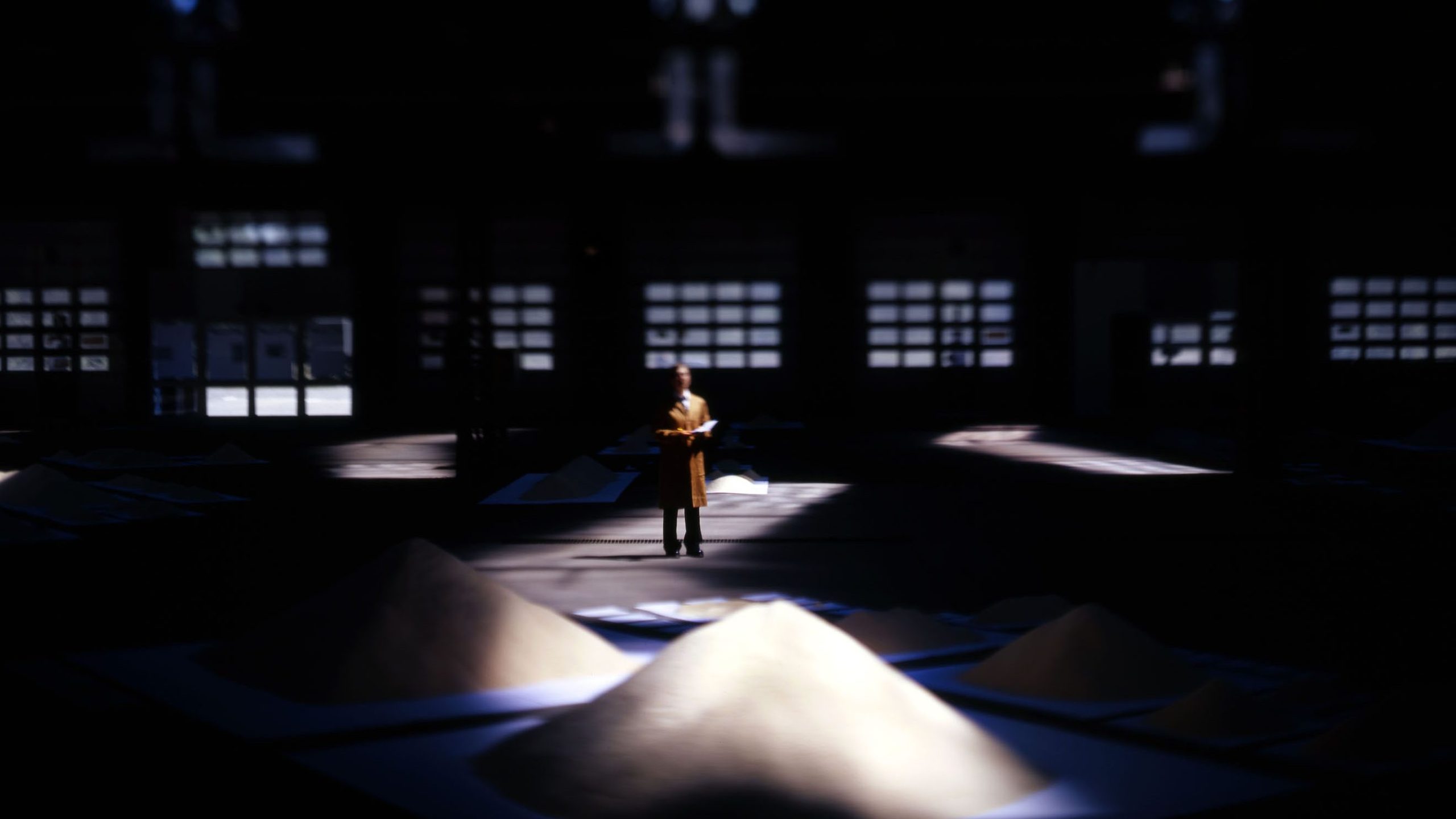
You learn more in five minutes in this show than reading the whole of the New York Times
Lou Reed
Of All The People In All The World uses grains of rice to bring once abstract statistics to startling and powerful life.
Each grain of rice = one person and you are invited to compare the one grain that is you to the millions that are not. Over a period of days a team of performers carefully weigh out quantities of rice to represent a host of human statistics
– the populations of towns and cities
– the number of doctors, the number of soldiers
– the number of people born each day, the number who die
– all the people who have walked on the moon
– deaths in the holocaust
The statistics are arranged in labelled piles creating an ever changing landscape of rice. The statistics and their juxtapositions can be moving, shocking, celebratory, witty and thought provoking.
Part amused, part amazed, one wanders through the hall, looks marvels and understands.
Neue Zuericher Zeitung
The show adapts to its setting: the country, city and building it is in. The amount of rice used varies according to which version is performed. It started in 2003 with Of All The People In All The World: UK using 1,000Kg of rice to represent the country’s 60 million population. Medium size shows may use 12,000Kg as in Of All The People In All The World: Europe. There have been two presentations of the definitive Of All The People In All The World in which the whole world’s population is represented. First in Stuttgart in 2005 with 104 tons and subsequently in Birmingham in 2008 with 112 tons. Staging the same version in 2022 would require 133 tons – fortunately we still peform small versions.
Witty, at times overwhelming and always thought-provoking. It is well worth going out of your way to see it. Wonderful.
Donald Hutera, The Times
The show responds to themes of festivals, current affairs, the interests and suggestions of its audience and mixes these with history and trivial from all walks of life. In 2004 a version of the show called Plague Nation was developed for use in schools focusing on epidemics and the history of vaccination. Workshops are organised around the show and for these teacher packs and student worksheets are available. The Wesleyan University in Connnecticut, set their environmental science undergraduates the challenge of researching facts for the show as part of their season Feet to the Fire: Exploring Global Climate Change from Science to Art.
The show’s deceptive simplicity engages people of all ages and backgrounds, causing them to reflect on their place in the world.
Centre For The Arts Wesleyan University
From this page you can view images and descriptions of all presentations of the show. You can read about the origins of the show, what it’s like to work on the show and more about the world versions in a series of essays. Your questions may be answered in the show’s own FAQ section .
This was a superb example of art for and about the average person on the street which takes the abstract and makes it powerfully representational.
Tom Ottoway


The knowledge gained is astonishing.
Sueddeutsche Zeitung
- How did you get the idea for the show?
- Why did you choose to use rice?
- What happens to the rice afterwards?
- Couldn’t you feed lots of starving people with this rice?
- How do you choose your statistics?
- Where do you find your statistics?
- How do you count the rice out?
- How does this work, I can’t be in two piles at once?
But is it theatre, or is it an installation? Such definitions seem to matter less than the power of a beautifully simple idea.
Terry Grimley, Birmigham Post
Stan’s Cafe are breaking the mould of what theatre can and might be with All The World.
Lyn Gardner, The Guardian
How did you get the idea for the show?
The short answer is that we wanted to understand how many people there are in the world. We knew the number was 6,200,000,000 but we didn’t know what this really meant. We thought if we could look at 6,2000,000,000 objects gathered together then that might help us understand.
A longer answer to this question is contained here:
Making Of All The People In All The World
Why did you choose to use rice?
We needed to find a substance that came in regular size grains so we could use a grains per gram calculation. We needed grains that were small, cheap, robust and which wouldn’t roll around. Rice qualified in all these ways. It also has powerful resonance being a staple food for much of the world and looking vaguely humanoid in close up.
What happens to the rice afterwards?
We own 1 ton of rice, which we reuse for all our small UK gigs. Elsewhere promoters supply our rice, part of the contract is they satisfy us that they will dispose of the rice ethically. For all large versions the show in Europe the rice has been taken back by the supplier for washing and resale. Smaller versions usually see the rice given away to charity or for animal feed.
Couldn’t you feed lots of starving people with this rice?
Rice from the UK version cost £400 would keep a small Chinese Takeaway going for two and a half months. On a global scale this is insignificant. The World’s food crisis centres on an unequal distribution of wealth not a lack of food. We dispose of our rice ethically (see the question above).
How do you choose your statistics?
Our choice responds to the show’s location and what is going on in the world at that time. We look to represent as broad a range of human activity as we can. Individual performers choose what statistics to place where in consultation with their colleagues and with regular input from visitors to the show.
Where do you find your statistics?
We draw statistics from newspapers, journals, academic books, the television, radio and internet. Sometimes we count them ourselves and on other occasions we ask people to supply them for us. We only use statistics from sources we have confidence in. Occasionally we place Official and unofficial versions of the same statistic together as an acknowledgement that we cannot take these numbers at face value.
How do you count the rice out?
We counted a large number of grains onto delicate scales and took an average for the number of grains per gram. We tend to count numbers up to 200 by hand and weigh out anything larger. Although this is inevitably an approximation so are most of the statistics themselves. Ultimately the show is about proportions, this beside that, using the same formula for all statistics keeps these proportions accurate.
How does this work, I can’t be in two piles at once?
Occasionally people think the show is flawed because they belong in two piles at once but shouldn’t be counted twice. The simplest way to think of it is to consider the grains of rice as actors, in the UK version the cast is the population of the UK, but more than one rice-actor could play you at the same time in two different piles.






